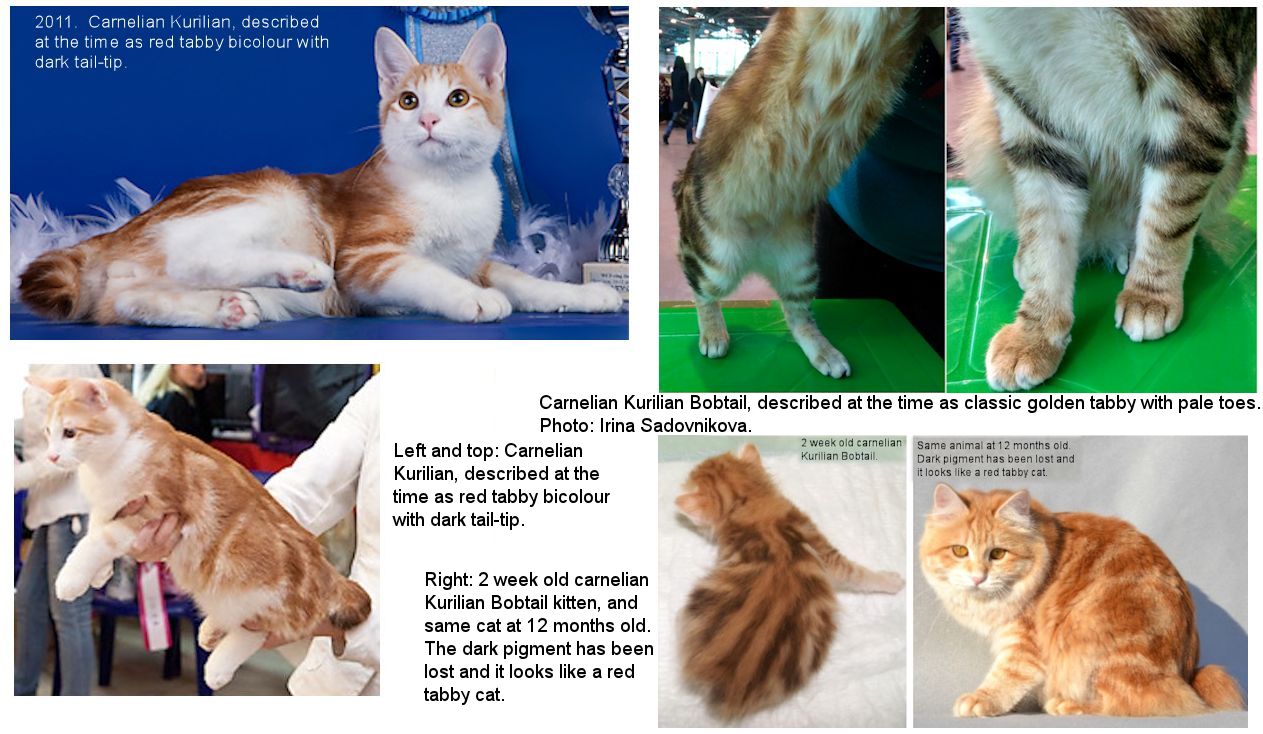
EXTENSION GENE: CARNELIAN (COPAL, SERDOLIK) KURILIAN BOBTAIL CATS
Terminology: the gene and colour is "carnelian," and in the Russian language it is "serdolik." This takes precedence over the name "copal."
The first mention of the new colour was at the 23rd International Colloquium on Animal Cytogenetics and Genomics (23 ICACG) June 9–12, 2018, Saint-Petersburg, Russia (Galkina S, Vishnevskaya M (2018)) Comparative Cytogenetics 12(3): 299–360. “A new mutation in the MC1R gene is responsible for golden and carnelian coat colours in the Kurilian Bobtails” Elina Bychkova, Anton Markov, Natalia Golubeva, Yulia Golovacheva, Elizaveta Filippova. In brief this says that the golden colour occurs in many breeds of cats and has various forms of manifestation. The Kurilian Bobtail exhibits both the golden colour, and recessive yellow colour called “carnelian” in its phenotype. As a result of the full sequencing of the coding region of the MC1R gene, a new mutation was identified. The results of testing suggested that the mutant allele (ec) in combination with the wild type allele (i.e. heterozygous) resulted in a golden colour, and in a double dose (i.e. homozygous) resulted in the total absence of eumelanin in the hair, producing the carnelian colour.
In terms of naming the mutation, “A New Mutation in the MC1R Gene Leads to Unique Carnelian Color in Kurilian Bobtails,” takes priority. Its publication in a journal was delayed due to the policy of St. Petersburg State University where there is a "queue" of articles for publications in their journal. The name “carnelian” takes precedence. A genetic test is available has been available from Zoogen for a long time and is based on their own research. The breeders must be commended for maintaining and selectively breeding an unrecognised colour for 15 years.

Irina Sadovnikova provides this information and most of the images on this page:
Nadezhda Flegontova was the first to pay attention to unusually coloured cats whose colours were a mix of red and light silver. The mysterious “reds” that could never have been born from the known parents according to Robinson’s genetics plagued judges in shows. All the doubts came for a while into the category of “unusual torties". But the observations went on. In 1998 judge Olga Mironova first noticed in Krasnoyarsk “reddish golden” Kurilians of an unusual hue, like the buffalo skin. Those were kittens of one breeder from “Catus” club, Svetlana Tyushnyakova. They got a description. Their pedigrees were researched. The kittens were red all over, with just some black hairs on the tail tip. With age some of them lost even those hairs. The parents were neither red nor tortie. Orange could not have occurred.
Line breeding of these unusual cats in Cheliabinsk and Moscow resulted in a group of optically red Kurilians. Nadezhda Flegontova presented them in 2001 in a “Felis” seminar for judges and breeders from many clubs and diverse parts of Russia. The question was mooted: how to classify these unusual cats from silver and golden parents for judging? As the colour had not been studied and understood yet, the decision was not taken. Their “red” colour was impossible according to genetic laws. The judges decided to research the colour. However, there was neither a name for it nor any understanding at that time.
As there were more and more Kurilian Bobtails of the strange red colour, sometimes with slight black tipping, in shows, they got the name analogous to Norwegian Amber – Kurilian Amber, Kur-Amber. Some years ago “Kurilian Amber” was sufficiently studied as a phenomenon of cat fancy, its features were captured. A big population of cats was already present. There appeared an urgent necessity to give a name to this colour and show it to specialists. Breeders and specialists who participated in the research (Vera Gubina, cattery Mau Kuril; Tatiana Nikitina, cattery Tamurni; Natalia Golubeva, felinologist and geneticist; Olga Mironova, AB judge; Anton Markov, Head of the Veterinary Genetics Centre “ZOOGEN”) are sure that the name for this colour should be chosen by the research pioneers. We suggest to call it serdolic - reddish and brownish hues with pale insertions. In Russian, sard, carnelian, is the name of a semiprecious stone found in the Urals.
The action of Serdolic is somewhat similar to amber but much stronger than that of amber or russet. The colour change occurs in the womb, kittens are born already almost deprived of the black pigment. Moreover, in the presence of the dominant allele A and the inhibitor of melanin I or the inhibitor of eumelanin Wb the action of serdolic appears to be semi-dominant: The action of ONE copy of es is visible in the phenotype. This action is in the process of research. Examples are silver and golden carriers. Silver (bimetal) and golden Kurilian bobtails are heterozygous carriers of the serdolic allele (Es es).
In the presence of A and es the melanin inhibitor gene I can not clear the hair on the underside of the body, creating an appearance of silver + golden in one cat. The red pigment is present on the belly, throat, face, breast and inner side of the legs - typical dorsoventral distribution. In the absence of A (solids) serdolic has no influence on I - smoke serdolic carriers have a black smoke appearance. In the presence of A the eumelanin inhibitor Wb together with es produces a specific appearance of golden Kurilians carrying serdolic: a peculiar brownish golden and dorsoventral paleness. Golden Kurilians do not produce brown tabby cats which is common in other golden breeds.
[In non-agouti with colourpoint]: The kittens have greyish brown or taupe markings. Later the colour changes to intense, even fiery red.
Marie Abitbol, Professor in Genetics, and Vincent Gache of the VetAgro Sup, Lyon Veterinary School in France, have also studied the extension gene locus. Mutations in the MC1R (melanocortin 1 receptor) gene cause extreme red-to-yellow colour changes in various species, sometimes termed "false red". In cats, the three alleles described thus far are amber (recessive, Norwegian Forest Cat), russet (recessive, Australian Burmese cats) and a dominant mutation in the Russian Kurilian Bobtail breed where brown tabby kittens are born with reddish tones which brighten to apricot red in adulthood as eumelanin (black pigment) disappears resulting in cats that resemble red tabbies. A mutation was found in the MC1R gene in the Kurilian cats. Cats that have the MC1R mutation exhibit the colour change.
The first report of the MC1R loss-of-function amber mutation in Norwegian Forest cats was published in 2009 (Peterschmitt M et al. (2009) Anim Genet 40, 547-52). A report on russet Burmese cats was published in 2017 Gustafson N.A. et al. (2017) Anim Genet 48, 116–20). The mutation found in Kurilian Bobtails is a different MC1R mutation called “copal.” Kurilians heterozygous for the serdolic/carnelian/copal allele are golden in colour. Further tests by Marie Abitbol have not found the MC1R copal mutation in Siberian “golden” cats nor in “copper” British shorthair cats.
Mutations in the MC1R (melanocortin 1 receptor) gene (E locus) cause extreme red-to-yellow hair or coat colours in various species. In cats, three alleles have been described at the E locus, including the e recessive amber allele in Norwegian Forest cats and the er recessive russet allele in Burmese cats. In Kurilian Bobtails, breeders described brown tabby cats born with a warm reddish tone and exhibiting a modification of their original colour during their first year of life. Kittens brighten and adults show an apricot-red colour. Eumelanin disappears from hairs and cats become very similar to sex-linked red cats. Pedigree data showed an autosomal recessive mode of inheritance. A comparison of the MC1R sequences from variant Kurilian cats, known carriers of the colour, non-carriers and an unrelated brown tabby domestic shorthair cat revealed a single homozygous difference. The mutation will be easily detectable with a genetic test and be named the ec (copal) allele in cats in common format with the amber and russet alleles.
The "copal" mutation is not present in Siberian “golden” (sunshine) cats nor in “copper” British shorthair/longhair cats. So these two traits do not have causal genes/mutations identified yet. Kurilian and Siberian breeders register their warm-toned black/brown tabby cats as "golden" to describe their brighter background colour. This causes problems if such a cat is transferred to a registry that understands golden to be related to silver and doesn't recognise that it can be a completely independent trait. At least in Kurilians there is now an identified gene to solve this problem.
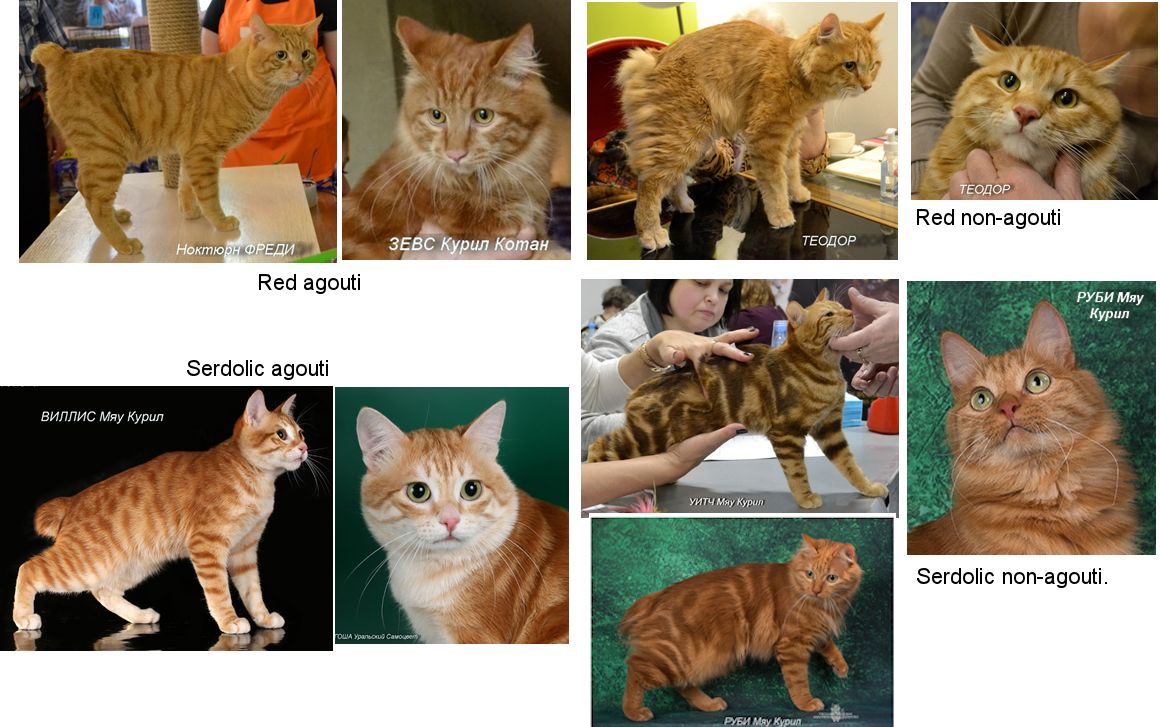
CARNELIAN COLOUR AND ITS RELATIONSHIP TO AGOUTI AND SILVER
Colours in mammals is the result of a combination of eumelanin (black-based pigment) and pheomelanin (red-based pigment). The relative amounts of each pigment determine the overall colour. The general mechanism of switching between pigments is known, but there are other genes that exert fine control and determine the exact shades. “Normal” red is due to the “orange” gene located on the X chromosome and inherited in a sex-linked manner (i.e. males are either red or not-red because they have only one X chromosome, but females are red if they inherit 2 copies, and tortie if they inherit one copy only). More recently, a number of red colours inherited in classic Mendelian fashion (dominant/recessive, not sex-linked) have emerged: “amber” in Norwegian Forest Cats, and “russet” in Burmese. These are due to mutations of the extension gene (E) and are associated with different mutations in the melanocortin receptor gene, MC1R, where they prevent eumelanin production. Amber (e) and russet (r) are inherited as recessive genes, but may be epistatic to alleles at other loci.
Breeders of Kurilian Bobtails described new colours in the “golden” group so a study was carried out on Kurilian Bobtails from the Gosha line of the Uralsky Samotsvet cattery. Five distinct types of orange colour were identified. One was the normal sex-linked red (O) mutation. The other four were not sex-linked. Pedigree analysis showed that all these colours came from a single allele that was epistatic to the agouti gene A (ASIP gene) and silver (SILV) and modified those colour. The new mutation is part of the “amber” group. Comparison to the known amber and russet mutations found the Kurilian Bobtail amber-like mutation to be a new MC1R mutation. The colour was named “carnelian” and given the symbol “ec” (extension carnelian / extension copal). The mutation was found in all Kurilian Bobtail cats with the carnelian colour and was not present in other coloured Kurilian Bobtails.
Carriers of one carnelian gene also show a colour change. The carnelian colours are:
Carnelian agouti (carnelian tabby): red-orange colour, sometimes bright and fiery. Each hair has agouti ticking, but the tip is not black. The red colour is most intense along the spine. The pattern on the sides is usually clearly expressed and contrasts with a less intense background colour. There are clear facial markings. The belly is lighter. The throat is significantly lighter in colour, appearing white, but the base of the hair is pale orange. The legs have the normal agouti colour distribution and pattern, but the toes are whitish. Carnelian agouti kittens may have a few black-tipped hairs, but these disappear with age.
Carnelian non-agouti (solid carnelian): the main tone is saturated brown-red-orange all over the body. Hairs are not ticked, but have a colour gradient along the length, forming a pattern. The tip has no black pigment. The back and sides are intense red-brown while the belly is orange-red. The limbs are red-brown with slightly lighter toes. There is a weak pattern on the face (due to fur length) but no tabby markings. Kittens are born darker and may appear brown tabby at first.
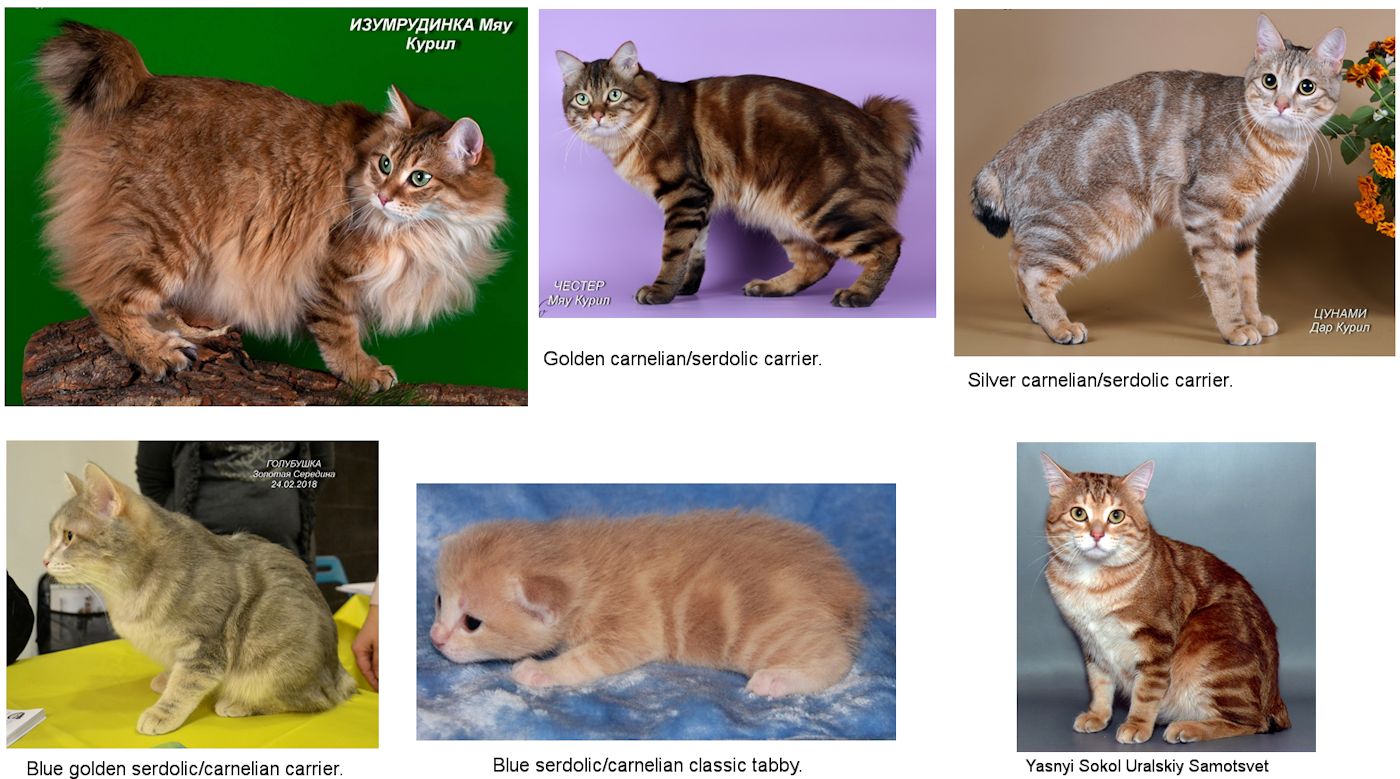
Gold carnelian carrier: Colour is saturated, with predominance from brown-orange to yellow tones. Base of hair is red without any grey body strip. The black pigment is concentrated on the upper part of the head, back and midline, with a pattern on the sides and the black tail-tip. Hair tipping in these areas is black from 1/8 to 1/3 of the hair length. Throat, belly, and inner surface of the paws are completely orange, with no black pigment present. There is a clear agouti pattern. The belly is lighter in colour and there may be whitish patches on the chest and belly. The clearly defined pattern on the sides and limbs is more brown in tone than the background colour and paw-pads are dark brown/black. Kittens are born darker, resembling brown tabbies, but they brighten with age (but not so much as amber Norwegian Forest Cats).
Silver carnelian carrier: There is a transition from silver (on the back) to gold (on the belly), often with no clear boundary where black ends and red begins. The back and sides have black pigment on a light undercoat (silver, from the inhibitor gene) which becomes brown-orange on yellow undercoat on the lower part of the body and underside. Both regions show normal agouti traits, albeit somewhat blurred. The darkest colour is on the back. The silver hairs can be up to ¾ black along their length, with uneven ticking. Red hairs can be found next to solid black hairs. Kittens appear mottled at birth, with black backs and lighter undercoats, but as they age the reddish colour becomes more evident.
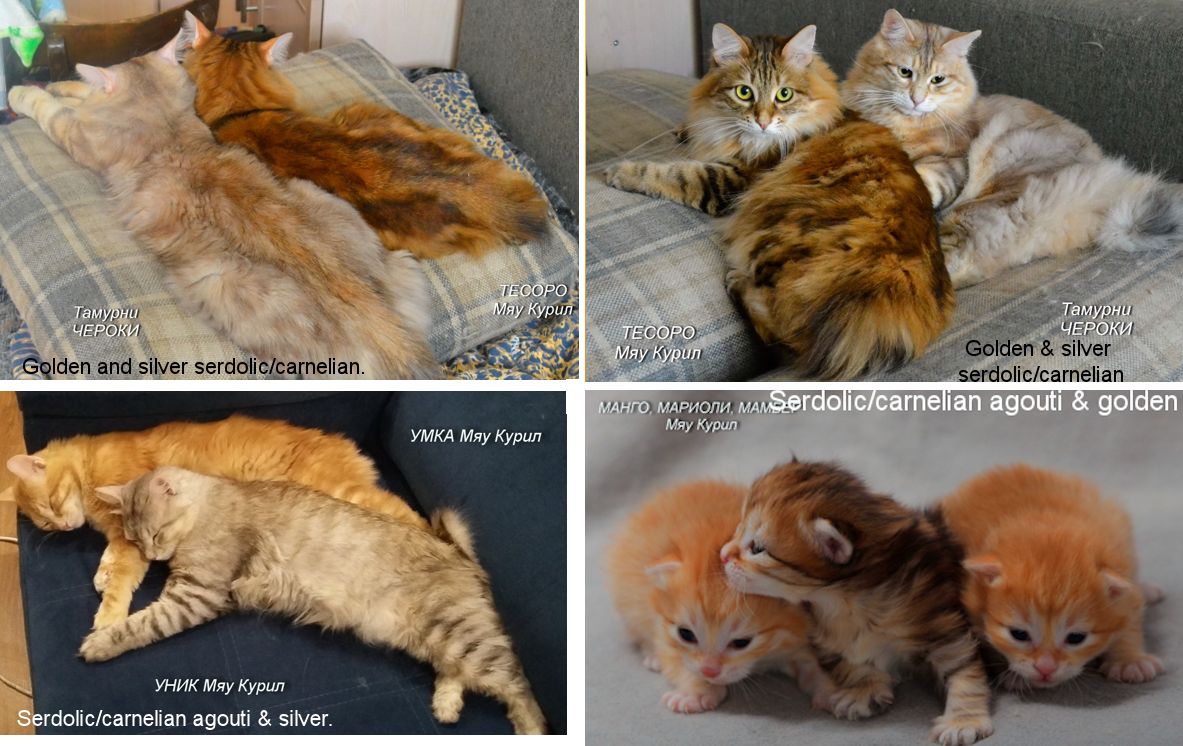
Carnelian has been seen in combination with colourpoint, but this has not been pursued and is not a recognised colour in the breed. Nevertheless it is very attractive.
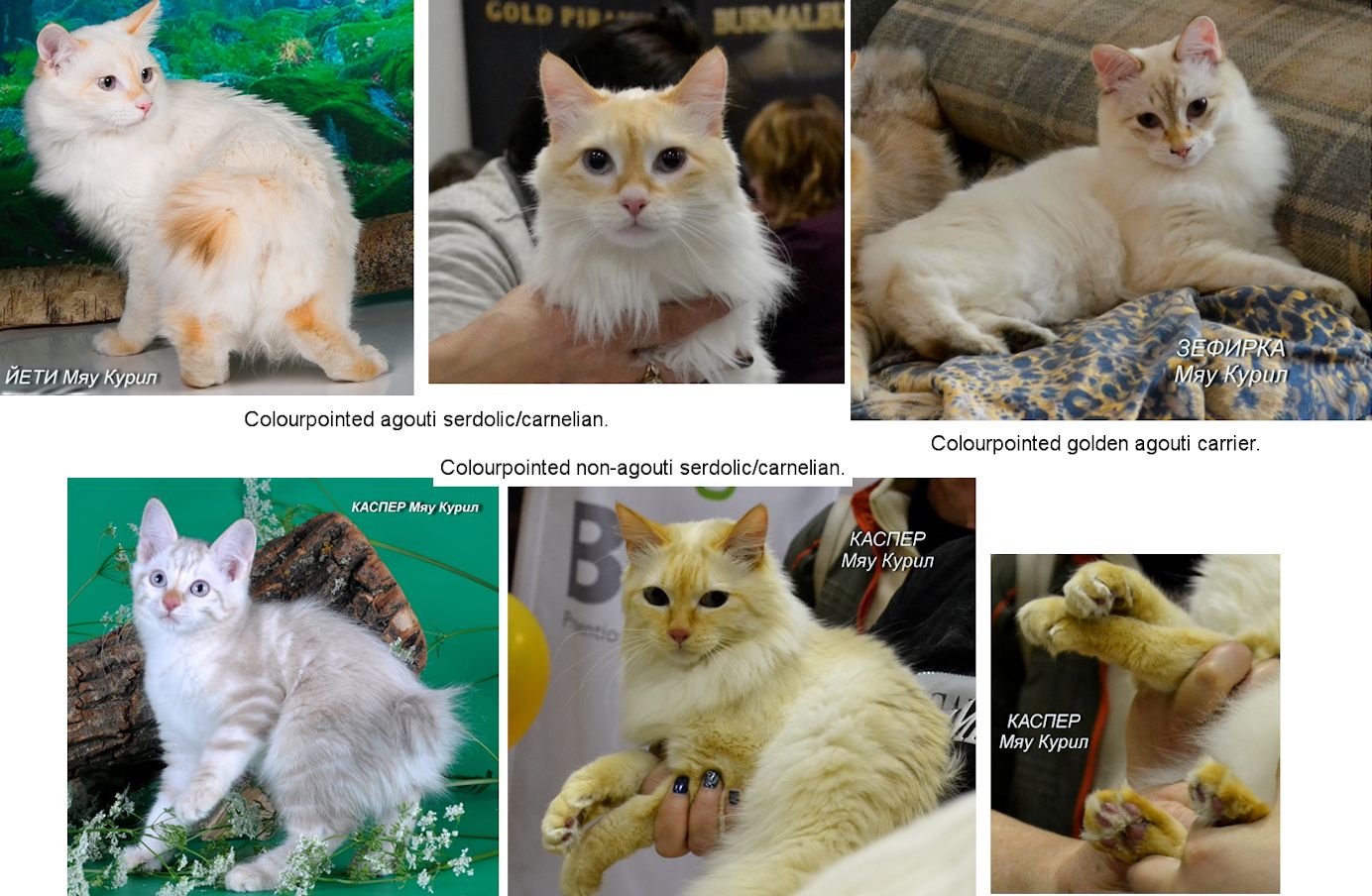
MY FIRST ENCOUNTER WITH SOME CURIOUS RED AND "TORTIE" CATS
The background to my personal study was a discussion on the inheritance of black tail-tips in some red/red-tabby Kurilian Bobtails. The cats were registered as golden shaded/golden tabby, but appeared was tortie or red, and from the very limited data, they bred as torties and reds.
In 2014, Anna Hakkarainen told me about some curiously coloured Russian-bred kurilian Bobtails. Some breeders had Kurilians that displayed amber-like colors and kittens that were born reddish with a black tail-tip. This occurred when both parents were registered as "golden" (e.g. golden shaded, golden tabby) which many breeders believed to be related to the silver inhibitor gene. Golden cats do not have to have silver ancestry - they can inherit the wide-band trait independently of the inhibitor, and the wide band trait produces the golden colour. The black tail-tips were consistent in the cats and were not birthmarks. Eumelanin (black/dark brown pigment) was somehow restricted to the tail-tip, with a black-to-red colour-change occurring before the kittens were born. Greyish pigment sometimes occurred on the tail, face and feet of genetically red cats, perhaps due to temperature.
Below is the pedigree of a visually red-and-white Kurilian Bobtail registered as “black golden shaded.” At first glance, the problem seemed to come from the mother's side where a phenotypic spotted tabby-tortie was registered as a black golden spotted tabby, but produced red kittens with black tail-tips. She also produced red-tabby-and-white female offspring which suggested she had to be a tabby-tortie (and have the O gene for red colour) and not a golden tabby. We also found a shorthaired red-tabby-and-white male kurilian Bobtail (with a dark tail-tip) that was registered as a black golden blotched (classic) tabby with white. Show judges in Russia had voiced concern over such cats not being the colour it said on the pedigree papers. Initially, research into extreme forms of wide banding suggested the pedigrees might be correct.
Looking at pedigrees and photos, there were discrepancies between the phenotypic (visually expressed) colours and the registered colour. The appearance of red/red-tabby cats that - at first glance - followed the rules of inheritance for sex-linked red, but whose parents were allegedly golden shaded/golden tabby cast doubt on the registered colours of parents and grandparents. The black tail-tip seemed to be a diagnostic feature of this red/golden colour where a genetically black cat manifested as red apart from the tail tip and paw pads.
Mistakes in pedigrees propagate throughout later generations until it becomes impossible to explain away the red cats in later generations. It is necessary to work backwards and re-evaluate the colours of the parents and grandparents. At first we wondered if "golden" was being used to describe different things. The old school of thought was that golden cats must have silver ancestry. This is because early silver/chinchilla breeders concentrated on getting clear silver backgrounds and very light tipping. They didn't realise that the silver colour came from the Inhibitor gene while the clarity and reduction in tipping came from the wide band gene(s). Wide band can be inherited independently of the Inhibitor gene, resulting in goldens. Hence golden cats need not have any silver ancestors.
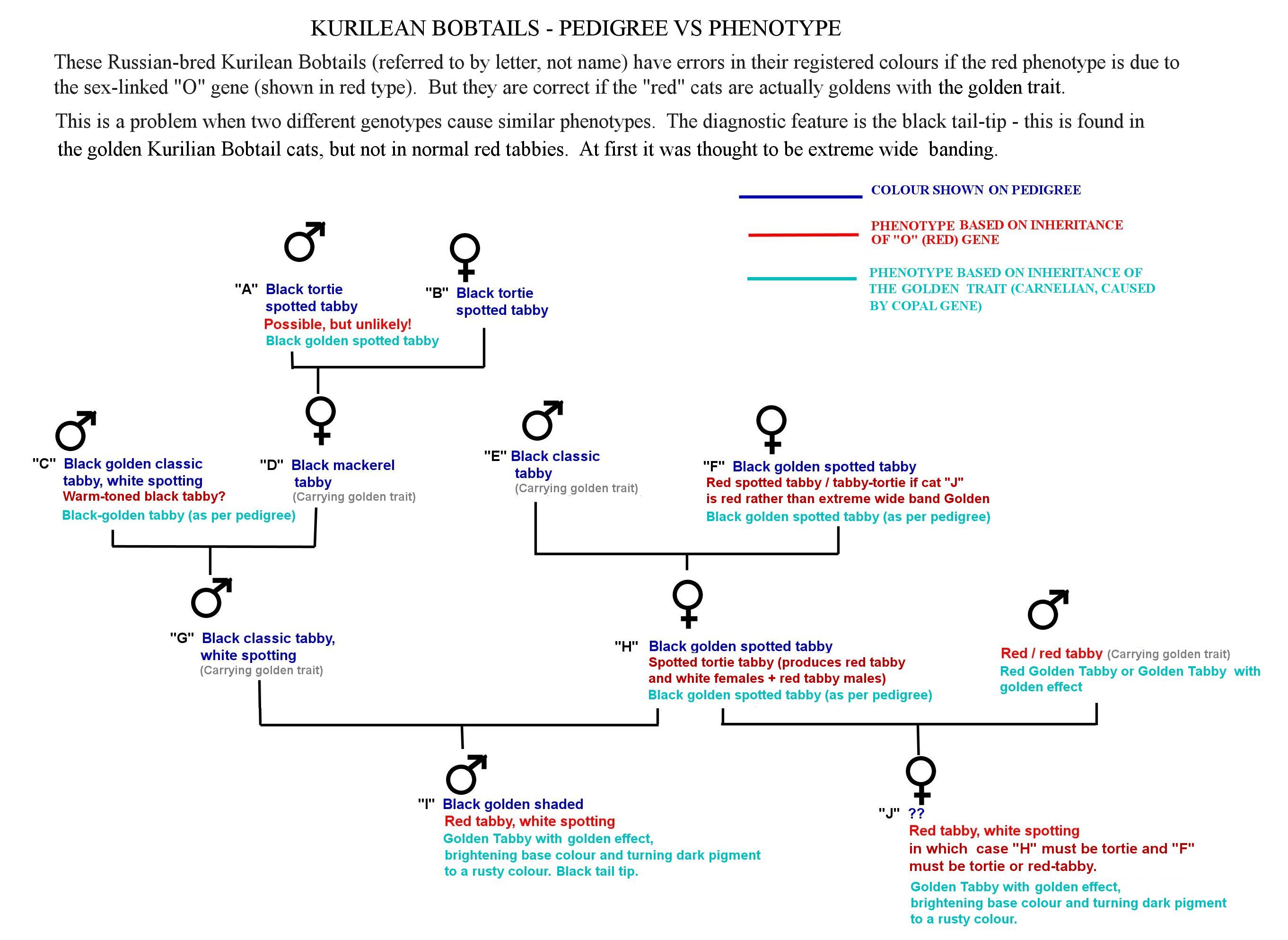
Chart showing Pedigree vs Phenotype.
This odd pedigree was resolved in 2017 with research into Golden Siberians and "Copper" British Shorthairs, even though the causal gene was not known at the time. Basically we worked on the theory that it was a new mutation, possibly "copper" (an informal term for an extreme wide band effect on ticked tabbies where the black pigment is almost absent except on the tail-tip and paw pads; when patterned tabbies inherit the same degree of wide banding their markings are reddish rather than black, but they still have a black tail-tip and black paw pads.) Ultimately it was not the same as "copper," but was equally exciting - a newly identified mutation!